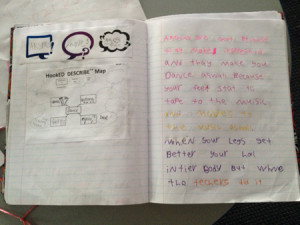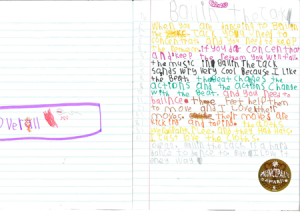This post acknowledges two ever fabulous teachers – Lynley Cummack and Rachel Saxton – and the work they do with primary and secondary students using classroom based approach to SOLO Taxonomy in New Zealand.
When I worked with Lynley Cummack (Team Leader for Hurunui Team at Waimairi School) last month, she set me up for success in a demo lesson using SOLO Hexagons with her five year olds – anyone who has had to do a demo lesson with a group of 5 year olds knows this is no simple undertaking. My previous encounters with five year olds include experiences more suited for the Edinburgh Comedy Festival than effective pedagogies (just ask Nick or if you think she exaggerates – ask the still traumatised 5 year olds who watched me Christo wrapped in pink tulle and armed only with drinking straws – Richard Scarry ooching my way across the carpet towards them (if you have to ask – it was an earthworm locomotion demo – featuring longitudinal and circular muscle contraction including setae).
Lynley shared amazing examples of her five and six year olds (junior school) written language.


Lynley scaffolds her student writing using the SOLO Describe Plus Plus map and a cut down version – using one strand from the map. Her approach is nuanced and worth sharing more widely as is the observation that Waimairi Primary School uses SOLO mapping to great effect to support student literacy. Lynley uses a single strand of the HookED Describe Plus Plus map in a SOLO Literacy Sticker Strip shown above to prompt student thinking at multistructural, relational and extended abstract levels BEFORE students move onto planning their writing using the HookED Describe ++ map template.
- Rectangles ask the learner to describe what they can see (hear, smell, feel etc.). Multistructural task
- Speech bubbles ask the learner to explain how or why they think this is like it is. Relational task.
- Thought bubbles ask the learner to reflect on what this makes them wonder. Extended abstract task.
Like the SOLO maps, the SOLO Literacy Sticker Strips help students draft one idea into a simple sentence, complex sentence and paragraph using question prompts for multistructural, relational and extended abstract outcomes.
I am currently co-authoring a book on using SOLO in learning support environments with Rachel Saxton – Head of Special Needs at Lincoln High School in Christchurch. Learning within the LHS department is deeply embedded in the social experience. LHS teachers use SOLO to scaffold learner competencies and confidence for learning in a specially designed modern learning environment. Like the students at Waimairi School, LHS students use the SOLO Maps to help support their literacy outcomes. In the Special Needs Department, students use SOLO alongside cut down versions of the SOLO Describe ++ and other SOLO maps.
In our SOLO in Learning Support book we will share some fabulous examples showing how student written language learning outcomes have improved using the SOLO mapping to draft ideas for writing.
In honour of the work Rachel and Lynley are doing to help students learn to learn with SOLO I offer two versions of the SOLO Literacy Sticker sheets to be used to scaffold student thinking before they take on the full version of the HookED SOLO Describe Plus Plus map.
Download SOLO Sticker Strips in Navy and 3Colours from the HookED Wiki Describe Plus Plus Map Page
If you have yet to try the the HookED SOLO Describe ++ Map start now. It is my favourite SOLO map. It is “the one map to rule them all”. I just love the way it helps students of all ages and stages to write. The map is a fabulous draft writing template for five year olds constructing their first simple sentence, for 18 year olds structuring their extended essay responses for NCEA Level 3 and for students of any age in learning support environments. It can be used to support student question making during student inquiry or scientific/statistical research. When combined with the HookED SOLO Five – five powerful questions for reflection – it helps students draft questions and answers for deep understanding.





